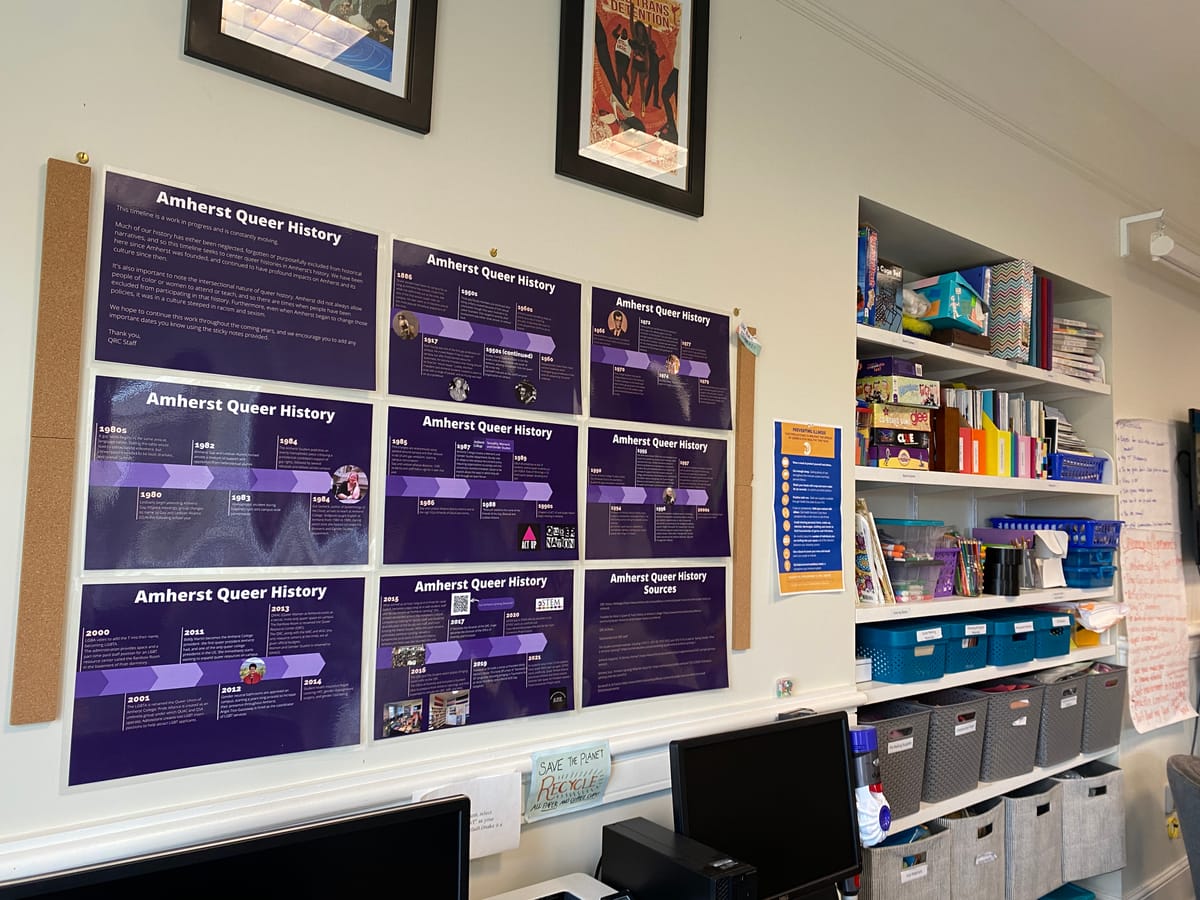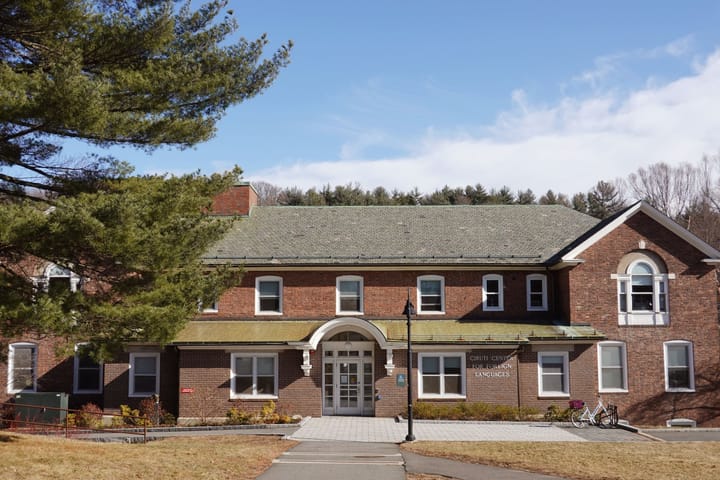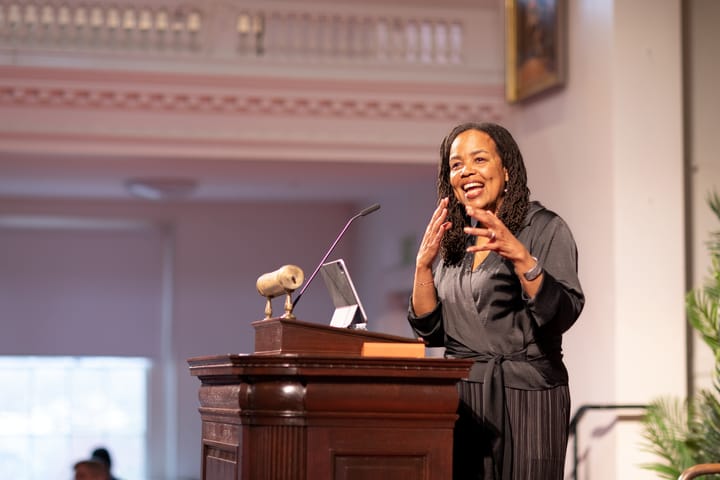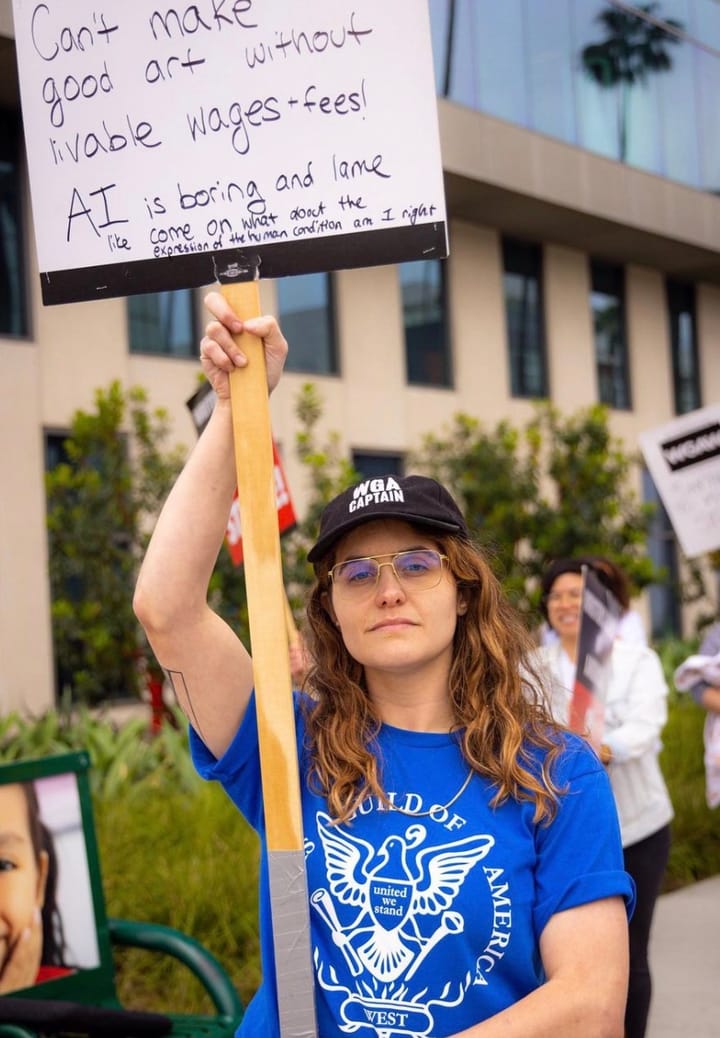Campus Corners: Amherst Queer History Timeline
A timeline hanging in the QRC documents figures, groups, and pivotal moments in the history of queer people at Amherst. QRC staff reflected on their experience researching and designing the timeline, and their belief in its value.

Enter the Queer Resource Center (QRC) on the second floor of Keefe Campus Center and, hanging by the window, you can find several large purple posters lined up together — a timeline documenting important figures, groundbreaking groups, and pivotal moments in the history of queer people at the college. This timeline is the culmination of many hours of research and planning by QRC staff members, who shared their thoughts on this experience and their belief in its value.
Moving through time, the selected events on the timeline do not separate resilience, joy, struggle, and progress from each other. Instead, they illustrate how these forces have been intertwined over time, and how student activism often drove progress forward.
Dating back to 1886, the timeline’s first point recognizes Clyde Fitch, who was one of the first known queer men at Amherst. “Queer people have been on campus for as long as Amherst has existed,” the timeline reads. Some other dates include events such as three gay faculty members being dismissed from the college due to “scandals” that were never proven in the 1950s, Marshall Bloom, a gay student, using his role as an editor to guide The Student towards political issues and activism in 1966, students attempting to start a gay club in 1972 but being denied support from the broader college community, the start of “secret queer-only meetings” in the 2000s, and student health insurance expanding to include hormone replacement therapy (HRT), and gender reassignment surgery in 2014.
QRC Coordinator Madina Oraz ’25 first had the idea to create a historical timeline during one of the center’s training sessions at the start of the fall semester. They recalled learning about Tamara Johnson — a Black, trans woman who graduated from Amherst in 1973 and was known for, among many things, her vibrant musicality and campus advocacy. Learning about Johnson made Oraz realize how valuable it would be to “initiate some permanence” in an “acknowledgment of the long-running history of queerness on campus” by installing an exhibit developed from archival materials.
Director of Gender and LGBTQ+ Equity and Engagement Hayley Nicholas also emphasized the importance of this type of historical preservation. “As a queer person of color, I long for more complete histories — ones that haven’t been erased, sanitized, and made more palatable,” they said. “History helps us understand who we are and how we can grow.”
Over the course of the fall semester, Sam Hodges ’23, a program coordinator at the QRC, started on this historical work, poring over a number of research sources, including several past issues of The Student, newspaper obituaries, and testimonials from QRC staff. Alongside Sasha Heywood ’25, they looked through “a lot — a lot — of old news” and archival materials, finding stories, important dates, and other forms of documentation. As they worked, J.T. Martin, then-director of the QRC and current Interim Assistant Dean for the Office of Identity and Cultural Resources (OICR) helped point them in new directions and towards other important materials.
Hodges explained how fascinating it was to read these old stories and accounts from queer students and groups. “They describe it so well, and … they’re very good at finding the humor,” they said. “No one’s like, ‘Oh my god, we were exiled from campus and it was really difficult.’ It was. But also, ‘Yeah, we had this gay table, and we’d make fun of the straight people.’”
Given the depth and richness of these stories, Hodges said, at times it was difficult to sort “things that don’t really lend themselves down to dates,” like the way people described the culture, or specific stories. For example, they said, “How do you put a funny story about the gay table onto a timeline? No one even gives a 10-year estimate; they’re just like, ‘The gay table used to exist.’ When was that? And when was this?”
Hodges described finding a balance between using stories on the timeline and learning that “Those things are hard to pinpoint … I feel like it wouldn’t be as nice in the timeline, you know?” This was part of the inspiration behind the QRC’s bi-monthly historical highlights, which hang as posters in the center and share some of the stories that lack precise dates.
Oraz spoke on the timeline’s importance in allowing us to look back through queer history as part of the story of Amherst from its beginning. They described how sometimes it can be easy to think about the institution’s history in a reductive way, as if “we existed as a male[-exclusive] college for X amount of years, and then, ‘woo hoo: women!’ And then, ‘woo hooo: diversity!’” they said. But this framework “doesn’t seem real, and it feels so forceful, and kind of alienating.”
The timeline in the QRC is grounding, then, Oraz said, because walking into the room and seeing it hanging on the wall, you don’t “get a feeling of, like: [The] QRC, it’s something new, something fresh, and [that] queerness is something added on the layer of the college when it became diverse.” Instead, “it’s something that ran through the history [of the college], and there were layers to that,” they said.
While queer people have been present throughout Amherst’s history, the timeline also notes that because of the college’s policies of exclusion and broader systemic issues, that presence did not include people who were left out of the college entirely due to other components of their identity. “Amherst did not always allow people of color or women to attend or teach, and so there are times when people have been excluded from participating in that history,” the timeline reads.
As Nicholas put it, “The timeline illustrates very clearly what histories have been magnified. It forces us to pause and ask: Why have these stories been prioritized? What narratives are missing? What is not passed down? What is passed down but only to a select few?”
Oraz says they hope the timeline can generate more conversations about this topic. “I think the biggest part for me, as a person who holds a lot of identities that are non-dominant, is that it will produce more conversations about intersectionality,” they said. “For example, what was the influence of queer people of color? Or what is the position of queer people who are international students? How queerness interacts with being first-gen, low-income.”
Oraz questioned what people think of when they talk about “queerness at Amherst College,” emphasizing the importance of confronting the at-times comfortable relationship that the institution establishes between queerness and whiteness, and “why we lean towards appreciation and acceptance of certain gender identities, but not all of them.”
Hodges and Oraz both highlighted how this link to history motivates them in their own work at the QRC today. “You can see — it took so many steps to have any type of queer acceptance on campus, and then it took steps for the QRC to become a thing, and then it took steps for queer people to have the community, and then it took steps for queer alliance[s] to have so many clubs and associations, like QTPOC [Queer and Trans People of Color], QAA [Queer Athletes Alliance],” said Oraz. “When you see that there is some progression, you become motivated about your work, actually, because you understand that if at some point, we did start … then what I’m working on doing right now will do more.”
Nicholas agreed, noting that the timeline reflects the power of student activism for future generations. The timeline is “a reminder that these spaces are not a given but are made by the queer and trans people before us,” they said. “It’s a reminder that these spaces help us survive.”
In the end, Oraz said, they believe the timeline is valuable because it creates conversation. “A lot of times, I think people kind of downplay the importance of talking about something,” they said. “The idea of talking about something is also connected to the idea of being heard. And without generating the talking material, how can we hope to get heard?”
To view the timeline in person and get more specific information and dates, you can find it in the QRC on the second floor of Keefe Campus Center. The center’s open hours are from 11 a.m. - 8 p.m. Monday through Friday. The center also welcomes feedback on the timeline, which you can add to the bulletin board placed next to it in the QRC. For other updates, check out the center’s Instagram, @amherstqrc.





Comments ()